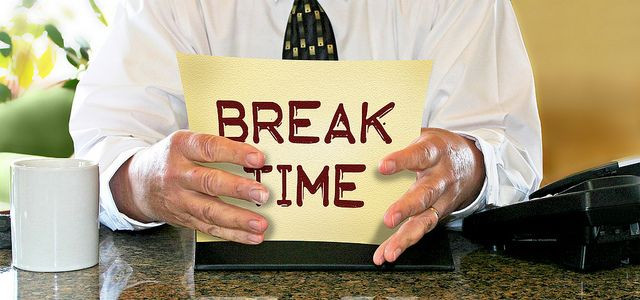Coffee Break, Lunch Break, 'Better Break': The Best Time To Take A Break From Work And Do Something You Enjoy

Everyone needs a break from whatever it is their doing. Nobody can withstand hours upon hours of the same thing ad infinitum, every day, for the rest of their lives. So we take breaks. Some people grab a coffee. Others grab a bite to eat. Some may even try and sneak a workout in, or just walk around their office until they decide to get back to work. Are any of these ways of taking a break actually better than the others? Two researchers decided to find out.
In a new study published in the Journal of Applied Psychology, Baylor University researchers aimed to provide a greater understanding of workday breaks, while offering suggestions on when, where, and how to plan the most beneficial daily escapes from work. Drs. Emily Hunter and Cindy Wu surveyed 95 employees aged 22 to 67 over a five-day workweek, and asked each person to document all the times they took a break during their workdays. The doctors defined breaks as “any period of time, formal or informal, during the workday in which work-relevant tasks are not required or expected, including but not limited to a break for lunch, coffee, personal email, or socializing with coworkers, not including bathroom breaks.”
A total of 959 break surveys were analyzed — amounting to two breaks a day per person — and they discovered some interesting things. For one, mid-morning was the most optimal time for a break. Hunter and Wu also found that breaking up the monotony of working hard throughout the morning replenishes energy, concentration, and motivation of employees and managers.
While mid-morning was the optimal time for a break, the researchers also suggested employees take “better breaks,” which incorporate activities that employees actually enjoy doing. That's not to say they don't enjoy work, though, as Hunter and Wu found that work-related activities also led to better breaks.
Taking these better breaks also caused employees to experience better health and increased job satisfaction. This meant that after their mid-morning "better break," employees reported less somatic symptoms, including headache, eyestrain, and lower back pain. They also reported feeling better about their jobs and a decrease in emotional exhaustion.
So, a mid-morning break doing something you find enjoyable is great, but how long should that break actually be? Hunter and Wu found that longer breaks were fine but it was also beneficial to take frequent shorter breaks.
"Unlike your cellphone, which popular wisdom tells us should be depleted to zero percent before you charge it fully to 100 percent, people instead need to charge more frequently throughout the day," Hunter said in a press release.
Source: Hunter, E. Wu, C. Give Me a Better Break: Choosing Workday Break Activities to Maximize Resource Recovery. Journal of Applied Psychology. 2015.
Published by Medicaldaily.com



























